Health Literacy among Japanese College Students: Association with Healthy Lifestyle and Subjective Health Status
Abstract
:1. Introduction
…people’s knowledge, motivation, and competencies to access, understand, appraise, and apply health information in order to make judgments and take decisions in everyday life concerning healthcare, disease prevention, and health promotion to maintain or improve quality of life during the life course.
2. Method
2.1. Participants
2.2. Procedure
2.3. Self-Perceived HL
2.4. Health Challenges Common to College Students
2.5. Health-Related Quality of Life
2.6. Quantitative Text Analysis
2.7. Statistical Analysis
3. Result
3.1. Characteristics and Acquisition Status of Health Information
3.2. Current State of HL
3.3. Relationships between Common Health Problems among College Students and HL
3.4. Association between HL Level and Health-Related QoL
3.5. Quantitative Text Analysis of Open-Ended Responses
4. Discussion
5. Conclusions
Supplementary Materials
Author Contributions
Funding
Institutional Review Board Statement
Informed Consent Statement
Data Availability Statement
Acknowledgments
Conflicts of Interest
References
- Sørensen, K.; Van den Broucke, S.; Fullam, J.; Doyle, G.; Pelikan, J.; Slonska, Z.; Brand, H. Consortium Health Literacy Project E. Health literacy and public health: A systematic review and integration of definitions and models. BMC Public Health 2012, 12, 80. [Google Scholar] [CrossRef]
- Berkman, N.D.; Sheridan, S.L.; Donahue, K.E.; Halpern, D.J.; Viera, A.; Crotty, K.; Holland, A.; Brasure, M.; Lohr, K.N.; Harden, E.; et al. Health literacy interventions and outcomes: An updated systematic review. Evid. Rep. Technol. Assess (Full Rep.) 2011, 199, 1–941. [Google Scholar]
- Eichler, K.; Wieser, S.; Brügger, U. The costs of limited health literacy: A systematic review. Int. J. Public Health 2009, 54, 313–324. [Google Scholar] [CrossRef]
- von Wagner, C.; Knight, K.; Steptoe, A.; Wardle, J. Functional health literacy and health-promoting behaviour in a national sample of British adults. J. Epidemiol. Community Health 2007, 61, 1086–1090. [Google Scholar] [CrossRef] [PubMed]
- The Japan Vision: Health Care. Available online: https://www.mhlw.go.jp/seisakunitsuite/bunya/hokabunya/shakaihoshou/hokeniryou2035/ (accessed on 7 December 2022).
- The Japan Vision: Health Care 2035 Executive Summary. Available online: https://www.mhlw.go.jp/seisakunitsuite/bunya/hokabunya/shakaihoshou/hokeniryou2035/assets/file/healthcare2035_proposal_150609.pdf (accessed on 7 December 2022).
- Conley, C.; Kirsch, A.; Dickson, D.; Bryant, F. Negotiating the transition to college: Developmental trajectories and gender differences in psychological functioning, cognitive-affective strategies, and social well-being. Emerg Adulthood. 2014, 2, 195–210. [Google Scholar] [CrossRef]
- Deasy, C.; Coughlan, B.; Pironom, J.; Jourdan, D.; Mannix-McNamara, P. Psychological distress and coping amongst higher education students: A mixed method enquiry. PLoS ONE 2014, 9, e115193. [Google Scholar] [CrossRef] [PubMed]
- Bewick, B.; Koutsopoulou, G.; Miles, J.; Slaa, E.; Barkham, M. Changes in undergraduate students’ psychological well-being as they progress through university. Stud. High Educ. 2010, 35, 633–645. [Google Scholar] [CrossRef]
- Ministry of Internal Affairs and Communications. Trends in digital utilization in Japanese people. Available online: https://www.soumu.go.jp/johotsusintokei/whitepaper/ja/r04/html/nd238110.html (accessed on 8 February 2023).
- Osaka City University. Available online: https://www.osaka-cu.ac.jp/en (accessed on 7 December 2022).
- Osaka Prefecture University. Available online: https://www.osakafu-u.ac.jp/en/ (accessed on 7 December 2022).
- Osaka Metropolitan University. Available online: https://www.omu.ac.jp/en/ (accessed on 7 December 2022).
- Nakayama, K.; Osaka, W.; Togari, T.; Ishikawa, H.; Yonekura, Y.; Sekido, A.; Matsumoto, M. Comprehensive health literacy in Japan is lower than in Europe: A validated Japanese-language assessment of health literacy. BMC Public Health 2015, 15, 505. [Google Scholar] [CrossRef] [PubMed]
- Sørensen, K.; Van den Broucke, S.; Pelikan, J.M.; Fullam, J.; Doyle, G.; Slonska, Z.; Kondilis, B.; Stoffels, V.; Osborne, R.H.; Brand, H. Measuring health literacy in populations: Illuminating the design and development process of the European Health Literacy Survey Questionnaire (HLS-EU-Q). BMC Public Health 2013, 13, 948. [Google Scholar] [CrossRef] [PubMed]
- The American College Health Association. Available online: https://www.acha.org/ (accessed on 8 December 2022).
- The National College Health Assessment. Available online: https://www.acha.org/ncha (accessed on 8 December 2022).
- Britt, R.K.; Collins, W.B.; Wilson, K.; Linnemeier, G.; Englebert, A.M. eHealth literacy and health behaviors affecting modern college students: A pilot study of issues identified by the American College Health Association. J. Med. Internet Res. 2017, 19, e392. [Google Scholar] [CrossRef]
- Fukuhara, S.; Bito, S.; Green, J.; Hsiao, A.; Kurokawa, K. Translation, adaptation, and validation of the SF-36 Health Survey for use in Japan. J. Clin. Epidemiol. 1998, 51, 1037–1044. [Google Scholar] [CrossRef] [PubMed]
- Fukuhara, S.; Suzukamo, Y. Manual of SF-36v2 Japanese Version; iHope International Inc.: Kyoto, Japan, 2004; Volume 2019. [Google Scholar]
- Mabuchi, Y.; Okawara, C.; Mendez-Ferrer, S.; Akazawa, C. Cellular heterogeneity of mesenchymal stem/stromal cells in the bone marrow. Front. Cell Dev. Biol. 2021, 9, 689366. [Google Scholar] [CrossRef] [PubMed]
- Berry, M. Survey of Text Mining; Springer: New York, NY, USA, 2004. [Google Scholar]
- Deguchi, M.; Yokoyama, H.; Hongu, N.; Watanabe, H.; Ogita, A.; Imai, D.; Suzuki, Y.; Okazaki, K. Eating perception, nutrition knowledge and body image among para-athletes: Practical challenges in nutritional support. Nutrients 2021, 13, 3120. [Google Scholar] [CrossRef] [PubMed]
- Yokoyama, H.; Deguchi, M.; Hongu, N. The role of diets and dietitians for para-athletes: A pilot study based on interviews. Nutrients 2022, 14, 3720. [Google Scholar] [CrossRef]
- Wolf, M.S.; Davis, T.C.; Arozullah, A.; Penn, R.; Arnold, C.; Sugar, M.; Bennett, C.L. Relation between literacy and HIV treatment knowledge among patients on HAART regimens. AIDS Care 2005, 17, 863–873. [Google Scholar] [CrossRef]
- Kebede, B.G.; Abraha, A.; Andersson, R.; Munthe, C.; Linderholm, M.; Linderholm, B.; Berbyuk Lindström, N. Communicative challenges among physicians, patients, and family caregivers in cancer care: An exploratory qualitative study in Ethiopia. PLoS ONE 2020, 15, e0230309. [Google Scholar] [CrossRef]
- Sukys, S.; Cesnaitiene, V.J.; Ossowsky, Z.M. Is health education at university associated with students’ health literacy? Evidence from cross-sectional study applying HLS-EU-Q. Biomed. Res. Int. 2017, 2017, 8516843. [Google Scholar] [CrossRef]
- Rueda-Medina, B.; Gómez-Urquiza, J.L.; Tapia-Haro, R.; Casas-Barrágan, A.; Aguilar-Ferrándiz, M.E.; Correa-Rodríguez, M. Assessing health science students’ health literacy and its association with health behaviours. Health Soc. Care Community 2020, 28, 2134–2139. [Google Scholar] [CrossRef]
- The Japan News. Govt to Set Up Japanese Version of CDC. June 15. Available online: https://japannews.yomiuri.co.jp/politics/politics-government/20220615-37786/ (accessed on 14 December 2022).
- Elsborg, L.; Krossdal, F.; Kayser, L. Health literacy among Danish university students enrolled in health-related study programmes. Scand. J Public Health 2017, 45, 831–838. [Google Scholar] [CrossRef]
- Rababah, J.A.; Al-Hammouri, M.M.; Drew, B.L.; Aldalaykeh, M. Health literacy: Exploring disparities among college students. BMC Public Health 2019, 19, 1401. [Google Scholar] [CrossRef]
- Marzo, R.R.; Su, T.T.; Ismail, R.; Htay, M.N.N.; Essar, M.Y.; Chauhan, S.; Patalinghug, M.E.; Kucuk Bicer, B.; Respati, T.; Fitriyana, S.; et al. Digital health literacy for COVID-19 vaccination and intention to be immunized: A cross sectional multi-country study among the general adult population. Front. Public Health 2022, 10, 998234. [Google Scholar] [CrossRef] [PubMed]
- Popa, A.D.; Enache, A.I.; Popa, I.V.; Antoniu, S.A.; Dragomir, R.A.; Burlacu, A. Determinants of the hesitancy toward COVID-19 vaccination in Eastern European countries and the relationship with health and vaccine literacy: A literature review. Front. Public Health 2022, 10, 672. [Google Scholar] [CrossRef] [PubMed]
- Fukuda, Y.; Ando, S.; Fukuda, K. Knowledge and preventive actions toward COVID-19, vaccination intent, and health literacy among educators in Japan: An online survey. PLoS ONE 2021, 16, e0257552. [Google Scholar] [CrossRef] [PubMed]
- Pimentel, S.M.; Avila, M.A.G.; Prata, R.A.; Nunes, H.R.C.; Silva, J.B.D. Association of health literacy, COVID-19 threat, and vaccination intention among Brazilian adolescents. Rev. Lat. Am. Enfermagem. 2022, 30, e3759. [Google Scholar] [CrossRef]
- Suzuki, T.; Ota, Y.; Sakata, N.; Fujita, N.; Kamatsuka, M.; Nagashima, K.; Hirayama, J.; Fujita, N.; Shiga, K.; Oyama, N.; et al. HPV vaccine intention among university students during suspension of active recommendation in Japan. Hum. Vaccin. Immunother. 2022, 18, 2116900. [Google Scholar] [CrossRef]
- Takeuchi, J.; Goto, M.; Kawamura, T.; Hiraide, A. Social regulations predispose people to complete vaccination for vaccine-preventable diseases. Tohoku J. Exp. Med. 2014, 234, 183–187. [Google Scholar] [CrossRef]
- Yang, S.C.; Luo, Y.F.; Chiang, C.H. The associations among individual factors, eHealth literacy, and health-promoting lifestyles among college students. J. Med. Internet Res. 2017, 19, e15. [Google Scholar] [CrossRef]
- Tsukahara, S.; Yamaguchi, S.; Igarashi, F.; Uruma, R.; Ikuina, N.; Iwakura, K.; Koizumi, K.; Sato, Y. Association of eHealth literacy with lifestyle behaviors in university students: Questionnaire-based cross-sectional study. J. Med. Internet Res. 2020, 22, e18155. [Google Scholar] [CrossRef]
- Stellefson, M.; Hanik, B.; Chaney, B.; Chaney, D.; Tennant, B.; Chavarria, E.A. eHealth literacy among college students: A systematic review with implications for eHealth education. J. Med. Internet Res. 2011, 13, e102. [Google Scholar] [CrossRef]
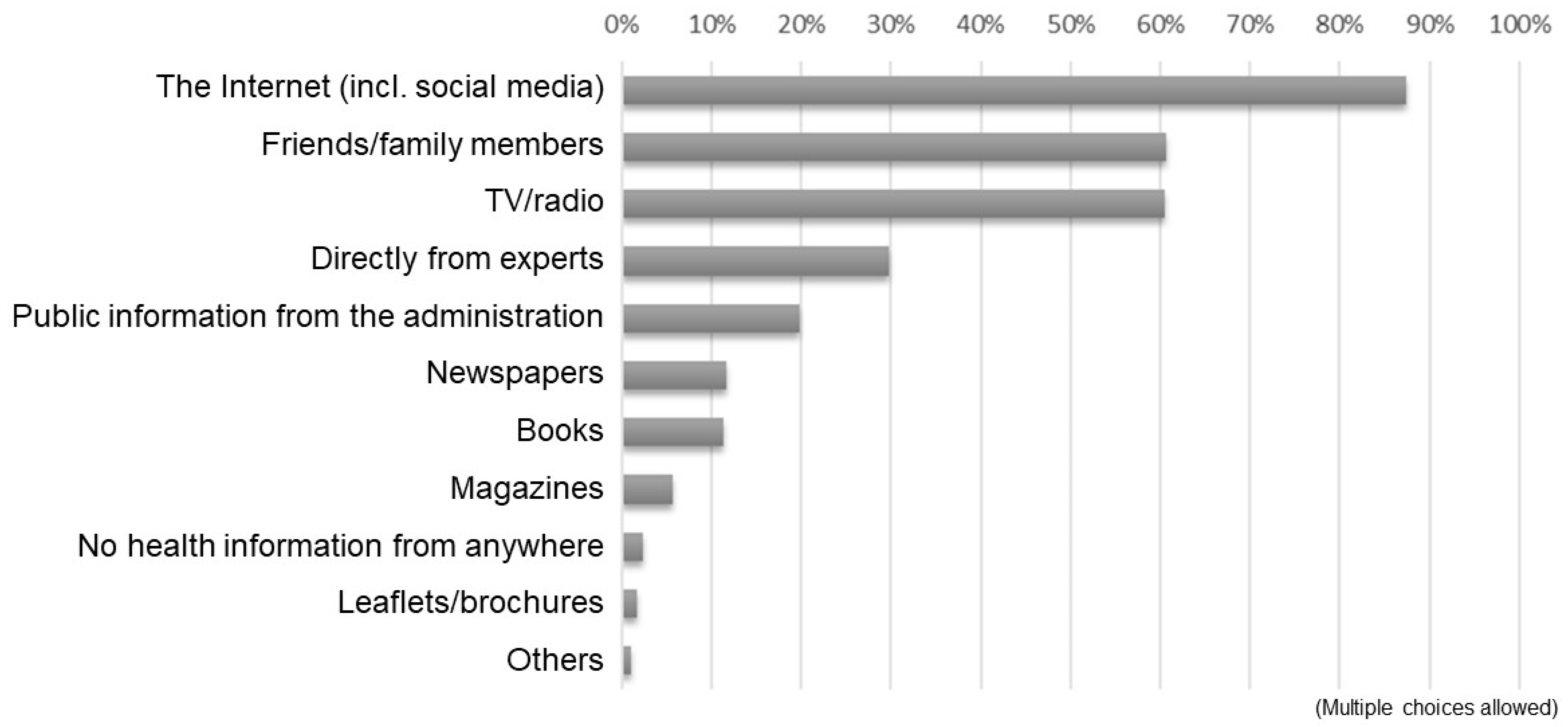
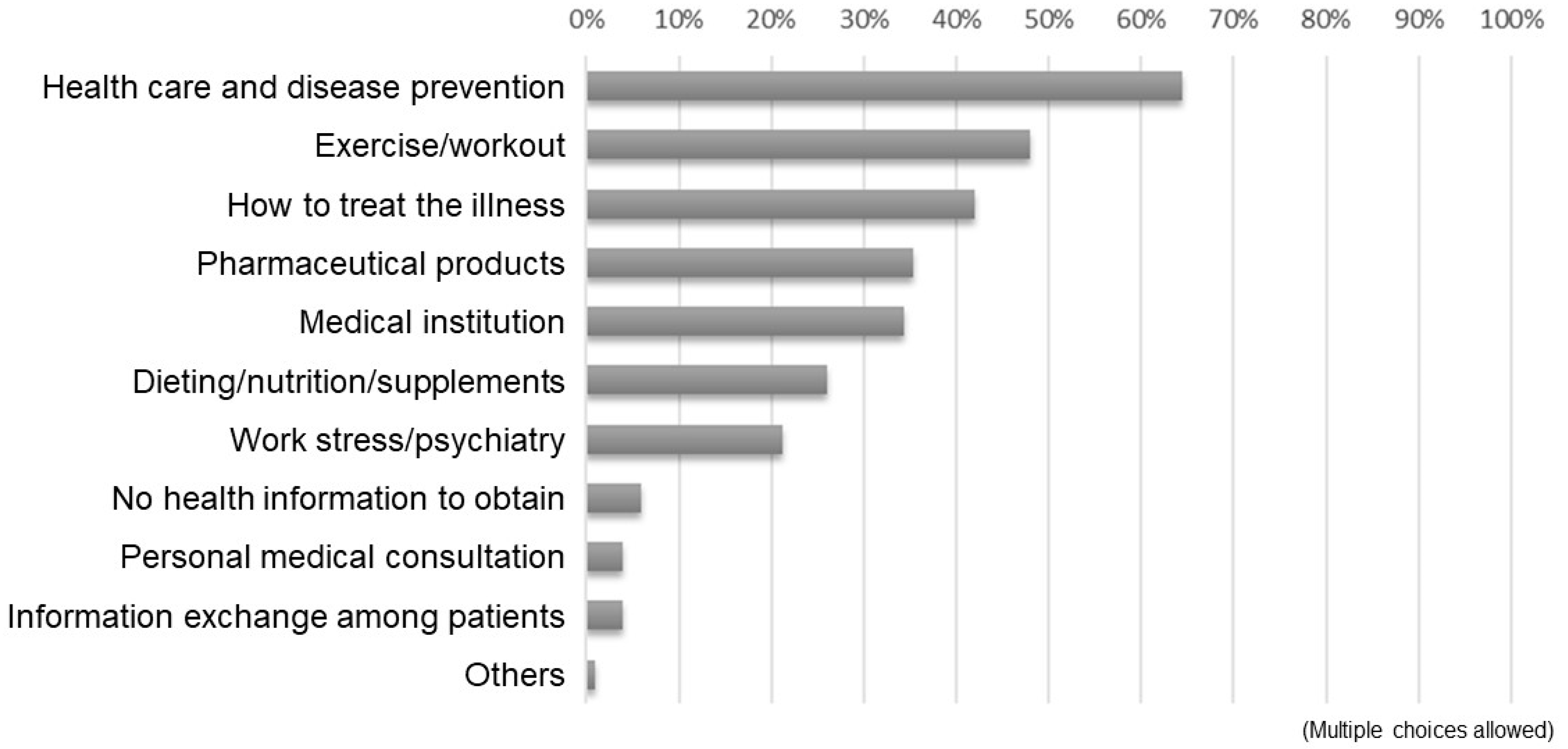
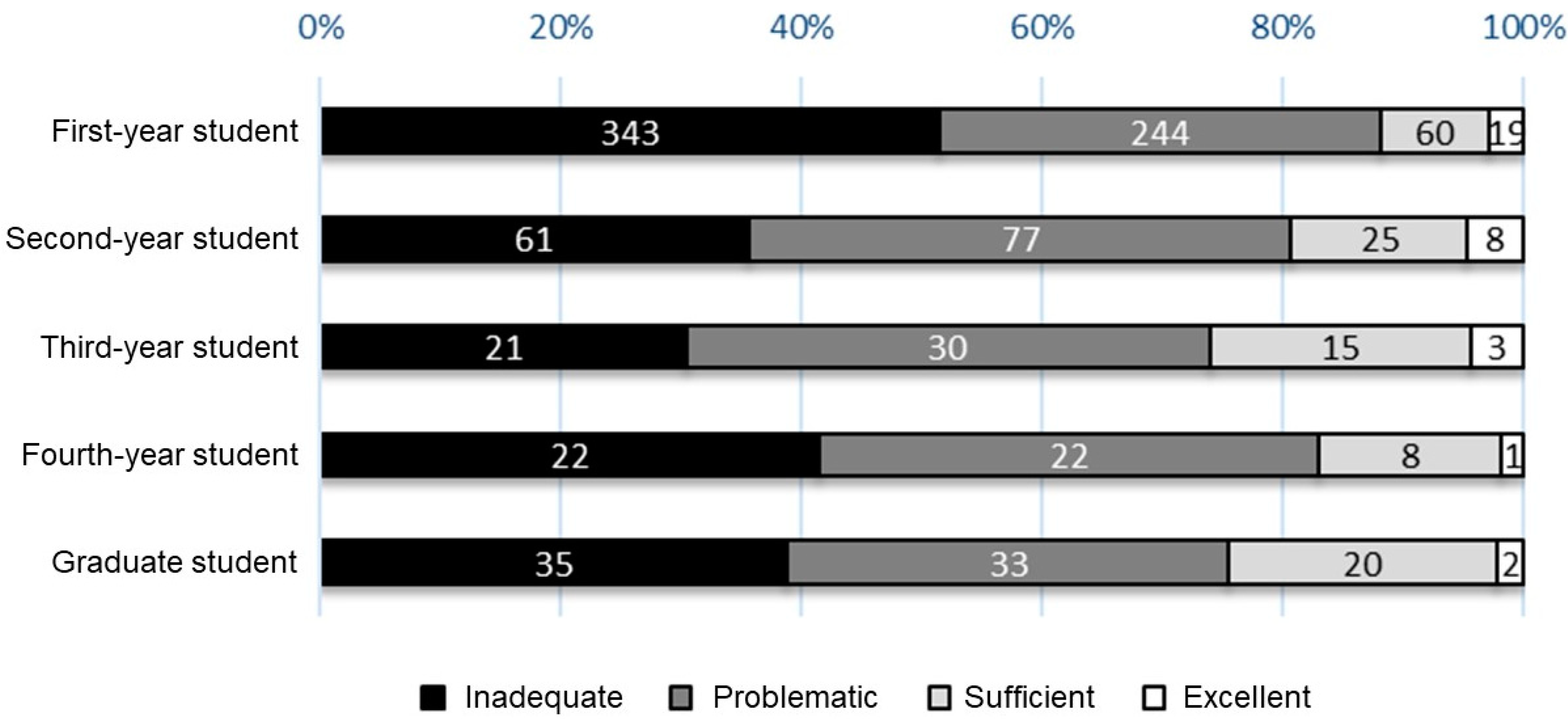
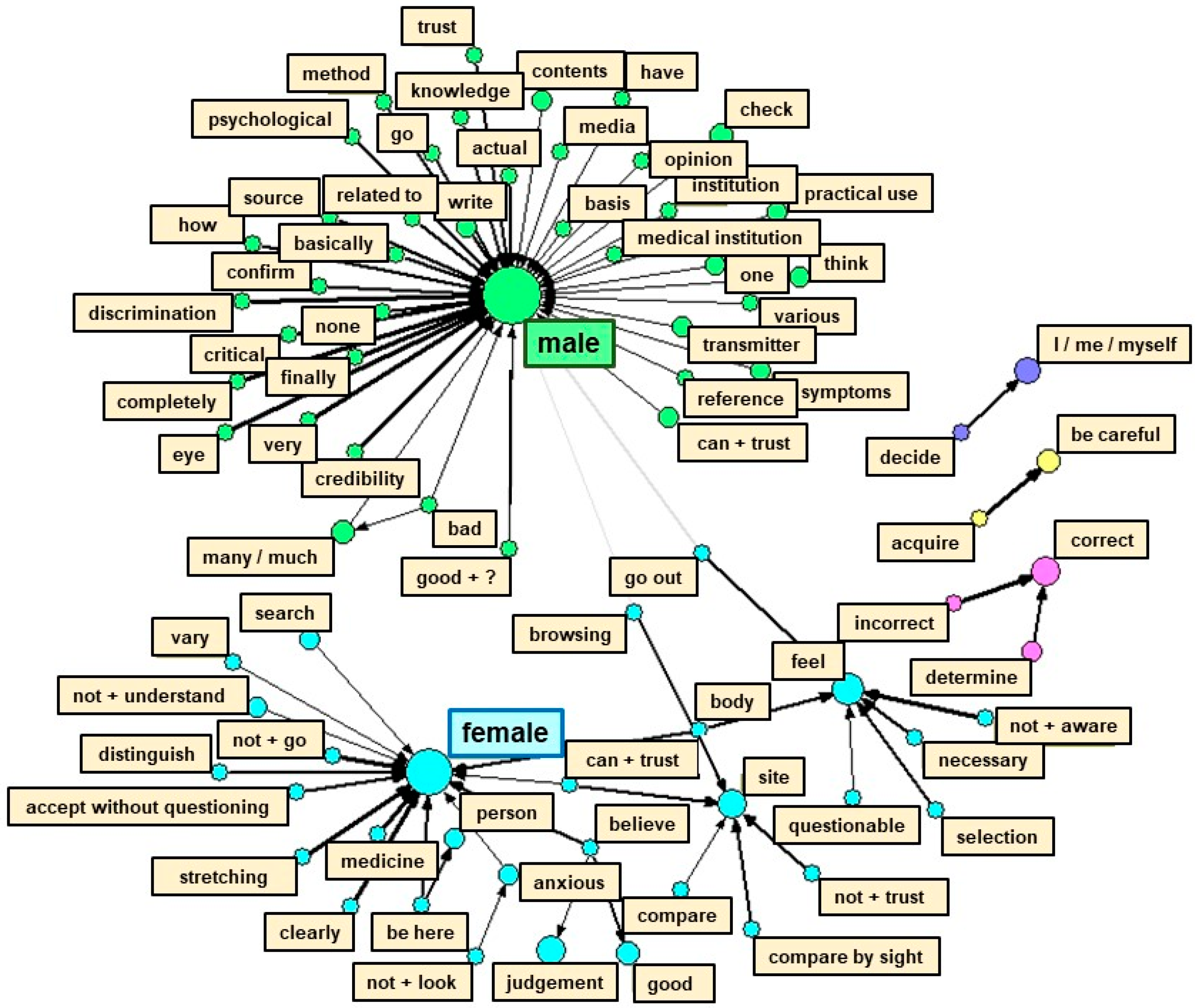
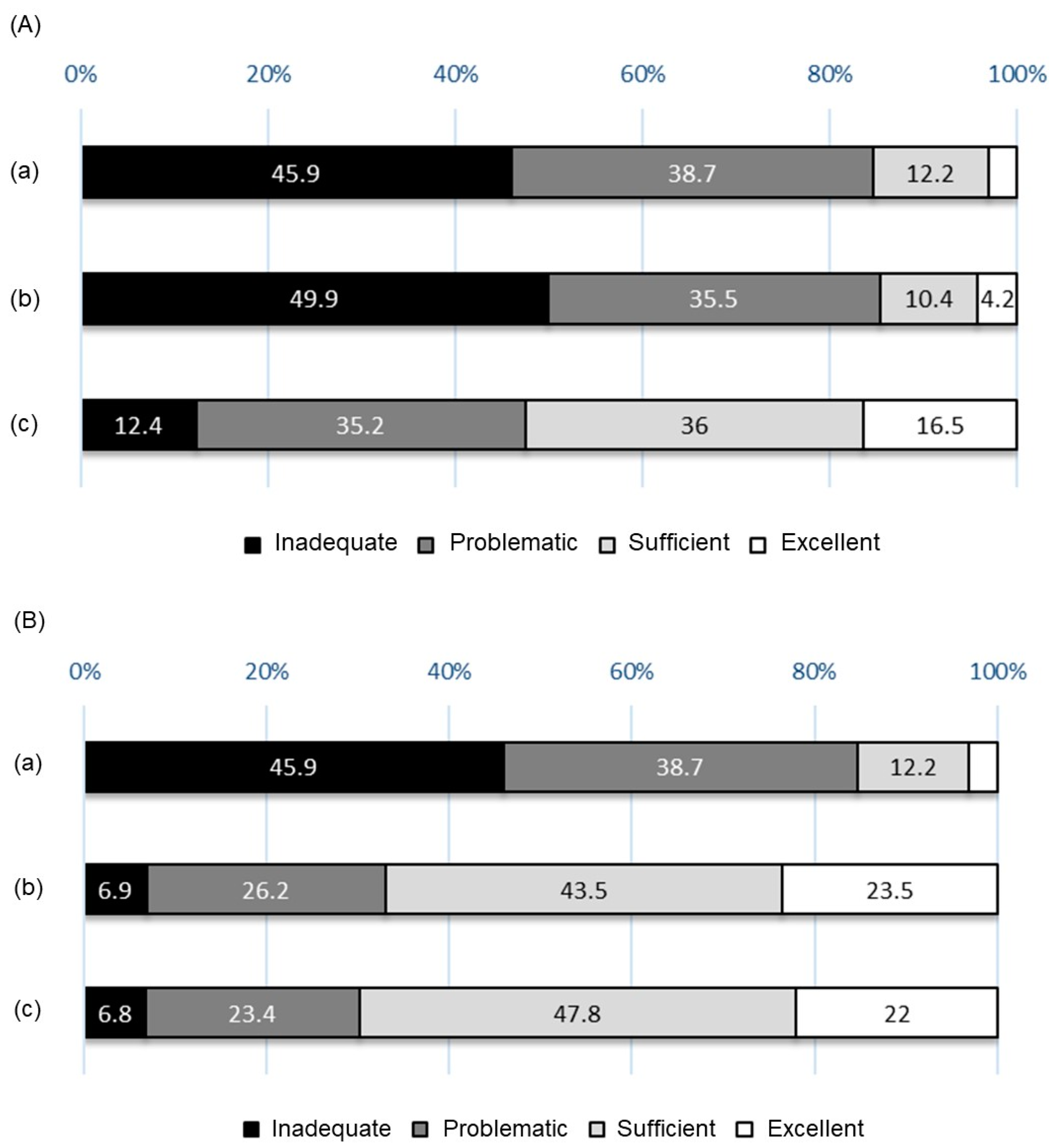
| Domains | Concepts |
|---|---|
| Physical functioning | Whether the person can perform various daily activities independently |
| Role—physical | Whether the person has had problems doing work or daily activities for physical reasons in the past month |
| Bodily pain | Whether the person has had bodily pain that has prevented him/her from doing his/her usual work in the past month |
| General health perceptions | Whether the person is in good health and can expect good health in the future |
| Vitality | Whether the person has been energetic without fatigue over the past month |
| Social functioning | Whether the person has had physical or psychological issues that interfered with relationships with family, friends, neighbors, or other associates in the past month |
| Role—emotional | Whether the person has had problems doing work or daily activities for psychological reasons in the past month |
| Mental health | Whether the person has been calm and happy in the past month |
| Total Number | 1049 |
|---|---|
| Gender (male/female/preferred not to respond) | 623/413/13 |
| Age | 19.8 ± 1.9 |
| Year level (first year/second year/third year/fourth year/graduate) | 666/171/69/53/90 |
| Competencies | ||||
|---|---|---|---|---|
| Domains | Accessing | Understanding | Appraising | Applying |
| Health care | 2.6 ± 1.0 | 2.7 ± 1.1 | 2.4 ± 1.0 | 2.8 ± 1.3 |
| Disease prevention | 2.7 ± 1.1 | 3.1 ± 1.8 | 2.5 ± 0.9 | 2.7 ± 1.1 |
| Health promotion | 2.6 ± 1.0 | 2.7 ± 1.1 | 2.5 ± 1.2 | 2.4 ± 1.1 |
| Item | Value |
|---|---|
| Total number of responses | 368 |
| Mean character count per response | 58.1 |
| Total number of sentences | 524 |
| Mean character count per sentence | 40.8 |
| Total number of terms | 4321 |
| Number by term category | 1220 |
| Rank | Term | Number of Occurrences |
|---|---|---|
| 1 | judgment | 67 |
| 2 | site | 60 |
| 2 | correct | 58 |
| 2 | I/me/myself | 43 |
| 3 | look | 42 |
| 3 | not + understand | 41 |
| 3 | good | 38 |
| 3 | check | 32 |
| 3 | be careful | 31 |
| 3 | acquire/get | 31 |
| 3 | many/much | 29 |
| 3 | multiple | 29 |
| 4 | write | 21 |
| 4 | can + trust | 21 |
| 4 | confirmation | 20 |
| 4 | disease | 18 |
| 4 | one | 17 |
| 4 | practical use | 17 |
| 4 | credibility | 16 |
| 4 | symptoms | 15 |
| Category | Examples of Responses Containing Words in Clusters | |
|---|---|---|
| Common responses of all participants | The difficulty of determining the truth of information | ・It is difficult to distinguish the truth of medical and health-related information without specialized knowledge. ・I feel that it is difficult to distinguish what is correct from a vast amount of information because the information written on each site is different. ・I believe that it is important to acquire HL because the Internet is full of incorrect information and it is difficult to find correct information. |
| Responses of male students | Looking at information with a critical eye | ・Health information obtained from social networking sites and personal blogs is first analyzed with a critical eye. ・I am always critical of information, no matter what medium it comes from ・I try to be scientific and critical about information when the source is not clear. |
| Not trusting completely and not believing everything you hear | ・I do not completely trust the information I receive, but only use it as a reference. ・I don’t think I can completely trust the information on the Internet or in the media, so I try not to take someone at their word. | |
| Verifying the source of the information | ・I try to confirm the information so that I can identify the transmitter of that information. ・I am careful to obtain only information from medical institutions and government agencies. ・I try to take the time to check if the source is an institution I can trust. | |
| Comparing multiple pieces of information | ・I try to check multiple sites, not just one. ・I compare multiple sites to determine which statements are facts and which are opinions. If multiple pieces of information have the same content, they are accepted as correct. | |
| Responses of female students | Being careful when there are obvious doubts about the credibility of information | I don’t easily trust something that is clearly different from the health knowledge I have gained from school or research papers. I’m trying to be careful about sites that are clearly talking nonsense. I distrust advertisements for supplements and other products that are clearly questionable. |
| Being unable to decide if one can apply the information to oneself | ・Even after researching my symptoms, I was unable to determine if I really had the disease, so it was difficult to take action and actually go to a medical institution. ・There is so much information out there that it’s hard to know what diet will work for me. ・I am getting information on stretching and weight training, but there is so much information that it is difficult to choose what is right for me. |
Disclaimer/Publisher’s Note: The statements, opinions and data contained in all publications are solely those of the individual author(s) and contributor(s) and not of MDPI and/or the editor(s). MDPI and/or the editor(s) disclaim responsibility for any injury to people or property resulting from any ideas, methods, instructions or products referred to in the content. |
© 2023 by the authors. Licensee MDPI, Basel, Switzerland. This article is an open access article distributed under the terms and conditions of the Creative Commons Attribution (CC BY) license (https://creativecommons.org/licenses/by/4.0/).
Share and Cite
Yokoyama, H.; Imai, D.; Suzuki, Y.; Ogita, A.; Watanabe, H.; Kawabata, H.; Miyake, T.; Yoshii, I.; Tsubouchi, S.; Matsuura, Y.; et al. Health Literacy among Japanese College Students: Association with Healthy Lifestyle and Subjective Health Status. Healthcare 2023, 11, 704. https://doi.org/10.3390/healthcare11050704
Yokoyama H, Imai D, Suzuki Y, Ogita A, Watanabe H, Kawabata H, Miyake T, Yoshii I, Tsubouchi S, Matsuura Y, et al. Health Literacy among Japanese College Students: Association with Healthy Lifestyle and Subjective Health Status. Healthcare. 2023; 11(5):704. https://doi.org/10.3390/healthcare11050704
Chicago/Turabian StyleYokoyama, Hisayo, Daiki Imai, Yuta Suzuki, Akira Ogita, Hitoshi Watanabe, Haruka Kawabata, Takaaki Miyake, Izumi Yoshii, Shinji Tsubouchi, Yoshimasa Matsuura, and et al. 2023. "Health Literacy among Japanese College Students: Association with Healthy Lifestyle and Subjective Health Status" Healthcare 11, no. 5: 704. https://doi.org/10.3390/healthcare11050704
APA StyleYokoyama, H., Imai, D., Suzuki, Y., Ogita, A., Watanabe, H., Kawabata, H., Miyake, T., Yoshii, I., Tsubouchi, S., Matsuura, Y., & Okazaki, K. (2023). Health Literacy among Japanese College Students: Association with Healthy Lifestyle and Subjective Health Status. Healthcare, 11(5), 704. https://doi.org/10.3390/healthcare11050704







